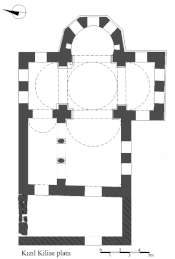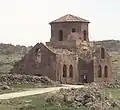Kizil Kilise
Kızıl Kilise, the Red Church, also known as Sivrihisar Kızıl Kilise, is a partially ruined sixth-century church in the Güzelyurt district of Aksaray Province, Turkey. The church takes its name from the red stone used to build it.[1] The building has been listed in the World Monuments Watch since 2008.[2]
| Kızıl Kilise Red Church | |
|---|---|
_01.jpg.webp) Kızıl Kilise in Güzelyurt, Aksaray after restoration | |
 Kızıl Kilise Red Church | |
| 38.26°N 34.43°E | |
| Location | Güzelyurt, Aksaray Province |
| Country | Turkey |
| Denomination | Greek Orthodox |
| History | |
| Status | Church |
| Architecture | |
| Functional status | Abandoned |
| Years built | 6th century |
| Specifications | |
| Materials | Red volcanic stone |
Background
Probably erected in the sixth century during the reign of the Byzantine Emperor Justinian I (r. 527–565), the edifice is one of the oldest Christian shrines of the Cappadocia region[3][4] and one of the oldest churches known to have a cupola on a drum with windows that illuminate the interior.[5] The church was possibly dedicated to Saint Gregory of Nazianzus, one of the fathers of the Cappadocian church.[5] The natives called it also as Saint Panteleimon Monastery (Μοναστήριον του Αγίου Παντελεήμονος).[6][7] which conflicts with existing claims of its name being Saint Spyridon.[8]
In central and eastern Cappadocia, 5th and 6th-century churches with cross-shaped plans were standard.[9] Kızıl Kilise follows this plan form, using local volcanic stones cut into regular blocks by highly skilled workers. Architecturally, the most characteristic element of the church is its central dome, erected above an octagonal drum.[5][10] Eight windows pierce the drum, flooding the nave with light.[5] The only later addition to the building is the narthex; otherwise the church, albeit damaged, still retains its original form.[5] The presence of huge lintels finished off using a highly professional technique hints to a usage as an imperial or burial chapel.[3] Pilgrims traversing Anatolia on the way to Jerusalem along an ancient route could readily reach the church.[4]
Gertrude Bell (1868–1926), the British archaeologist and writer, photographed and measured Kızıl Kilise in 1907.[11]
Kızıl Kilise was operational until the 1st of August 1924 by the Turkish-speaking Christians of Sivrihisar village, before they migrated to Greece with the Population Exchange.[7]
Reconstruction activities
In 2011 a program of reconstruction work began at the church.[4] International fundraising raised €500,000 to finance the work. İsmet Ağaryılmaz, a retired professor who previously taught restoration techniques at Yıldız Technical University, directed the project.[1][4]

Gallery
 Kızıl Kilise in Güzelyurt, Aksaray before restoration
Kızıl Kilise in Güzelyurt, Aksaray before restoration The Red Church in Cappadocia, Turkey in April 2017 following restoration in 2011.
The Red Church in Cappadocia, Turkey in April 2017 following restoration in 2011. Kızıl Kilise in 2010.
Kızıl Kilise in 2010._Innenraum.jpg.webp) Inside the church.
Inside the church.
References
- "French group vows to save Cappadocia's historic 'Red Church'". Today's Zaman. 2007-05-25. Archived from the original on 2014-10-26. Retrieved 2014-09-02.
- "Projets de sauvegarde" (in French). Association des Amis de la Cappadoce. Retrieved 2014-08-31.
- "Red Church". World Monuments Fund. Retrieved 2014-09-02.
- "Centuries-old church rescued in Cappadocia". Hürriyet Daily News. 2012-06-10. Retrieved 2014-09-02.
- Les Amis de Cappadoce. "Kızıl Kilise - The Red Church". www.wmf.org. World Monuments Fund. Retrieved 8 October 2014.
- Ν. Κ. Μουτσόπουλος, Η Κόκκινη Εκκλησία (Kizil Kilise) κοντά στο Sivri Hisar της Καππαδοκίας. Παρατηρήσεις και προβληματισμοί, ΕΜΣ, Θεσσαλονίκη 2007, σελ. 26.
- Κιτρομηλιδης, Πασχαλης Μ. (1982). Μουρελος, Γιαννης (ed.). Η Έξοδος. Τόμος Β'. Μαρτυρίες από τις επαρχίες της νότιας και κεντρικής Μικρασίας (in Greek). Athens, Greece: Κέντρο Μικρασιατικών Σπουδών. pp. 19–21.
- "GÜZELYURT'TA (GELVERİ! BULUNAN BizANS/POST-BİZANs DÖNEMi KİLiSELERİ 1".
- R. Krautheimer, "Early Christian and Byzantine Architecture", 1986, p164.
- "Cappadocia loving French association to save Red Church". Hürriyet Daily News. 25 May 2007. Retrieved 14 October 2014.
- "In the footsteps of Gertrude Bell". Today's Zaman. 2014-04-28. Archived from the original on 2014-09-03. Retrieved 2014-09-02.